In-between design & art: the sinister sci-fi of Audrey Large & Théophile Blandet
An exhibition at the Centre d’art
Contemporain Genève, Switzerland, explores the work of two emerging French designers who create work fixed in some unsure place between function & art. Will Jennings visits to discover more about the sinister amalgamations.
The floor rattles. Formed of a vast grid of timber blocks once
trapped firm between within the building’s solid concrete shell, they have
slowly been working themselves loose over the years since machinery and
industry were swapped. What was once a solid lump of industrial architecture is
now home to a cluster of Geneva’s art organisations, including the Centre d’art
Contemporain Genève, to who this rattling timber floor belongs and which is
currently showing Design in Metamorphosis, a conversation between the work of
Audrey Large and Théophile Blandet.
![]()
![]()
Geneva – a city which not so much straddles the Switzerland/France border than is entwined with it – is perhaps best known now as a centre of finance and diplomacy, a city of invisible hands moving invisible finance and anonymous technocrats handling secret negotiations. It is a city which has transitioned into one built around the management of abstraction and service of ideas out of what was a centre of watchmaker, jeweller, and craftsman Protestant refugees escaping France following the 1598 Edict of Nantes. It is then perhaps an entirely suitable context to think about the idea of metamorphosis and the betweenness of states, the migration of form or idea.
Both Large and Blandet are emerging French born creatives both now residing in Rotterdam, and this exhibition relocates their design-focused artworks into this former Genevan industrial concrete hulk of a bulding. At first glance the works read as furniture design, functional lumps of domestic design, albeit with brightly coloured and baroque flourishes. And so, sitting on plinths and reading as products of manufacture, they read suitably at home within such an industrial setting, within a place and history which was surely also about something as logical, physical, and immediate as product design.
But as visitors encircle the works to understand more, the floor continues to creak and crack. The foundations are unreliable, things may not be what they seem, everything here is in-between.
![]()
A chair sits, waiting to be used. It could be used, though it’s not inviting, functional but threatening. PPC-DH (Chair) (2019) by Blandet sets the tone, this is no architect-designed experiment in ergonomics, but more a statement of materiality, and some kind of melted, reconstituted, disturbed, deformed material at that. Half furniture design half art object, it is lumpen yet fluid with a geometric rough-cut rigidity fighting a blue marbling within, a site of change and transformation.
Nearby, an equally functional shelf also presents itself with horror. The top surface of Blandet’s PS (Wall Cabinet) (2018) is flat but everything else seems to be melting into time and space. Blandet describes it as “basically made of trash I found around my atelier in Eindhoven,” but the gallery listings offer an ingredients list: PS, PE, HDPE, POM, PCL, PETG, PTFE, PA, PMMA, HMA, PU, and polyester. This all speak to chemical (or alchemical?) ideas of melting, reacting, breaking apart, but also bonding, and it seems that somehow within that unlikely cocktail of letters there was a moment of bonding in which something functional accidentally formed. As if to evidence that function, the curators Barbara Brondi and Marco Rainò have perched one of Large’s works. Metabowl#13 (2020) is a small serpentine lump of 3D printed forms, half-on half-off the precarious surface.
![]()
![]()
![]()
Other works in the room by the Large are greater in scale and baroque form. Scale to Infinity (2021) is typical of Large’s sculptural objects, a seemingly chaotic amalgamation of 3D printed shapes interlocking, unashamedly showing joins and scars. “It is hand drawn and crafted in the blank space of 3D modelling software,” Large explains, pointing out shapes and forms that repeat not just within a work but across pieces as she builds a library of elements that deform and bend into new abstractions. “Is it made by human or machine, created by computer or person?” the artist asks rhetorically, answering herself: “It’s about a new dichotomy.”
We are deeply into the slow metamorphosis between analogue and digital. Some may say it began in the 1960s with cybernetics, others in the 1980s with home computers, perhaps deeper in time with Ada Lovelace. We don’t know, however, when or where it will end, and if we will reach a time when analogue is forgotten to history. We don’t know if the analogue-to-digital metamorphosis will end or forever mutate within the messy in-between. These works by Blandet and Large symbolise that in-between, or as Large describes it “a bridge between two worlds.”
Where Large lives in the digital realm of 3D software, Blandet’s work is fundamentally handmade – “He uses a hammer, so it’s really crafted,” suggests Rainò. As with the shelving earlier, many of the works are from found materials, rescued, and reimagined in a process the artist describes as “a journey about how you can make things by hand out of a material that is completely industrialised.” As a consequence, Blandet’s pieces do have a somewhat scavenged cyberpunk feel: rough-cut edges, melted joins, folded and twisted surfaces.
Perhaps suitably for an exhibition in Geneva, Blandet’s work often carries an aura of Swiss artist H.R. Giger about it. Wires spill out of the petal-laden orifice of a bitcoin mining cooling system, wrapping around a long pole are blue leaf-like growth emitting crystalline light, and in the centre of the room an absurdist tea fountain on wheels, seemingly melting under the weight of its own otherness. This sci-fi is sinister.
![]()
![]()
![]()
But behind the sinisterness of both artists’ creations, there is potential functionality as lights, tables, chairs, and desks – though the function is often concealed behind an art-object aesthetic, hidden amongst sculptural form. Large’s MetaShelve#1 (2020) conjures a feeling of Apollo and Daphne by Gian Lorenzo Bernini – if Bernini had eschewed marble in favour of garishly purple plastic. But where in the great baroque sculpture Daphne is transforming into a laurel tree as representation of Ovid’s tale, Large’s work has at its core the very functional mundanity of a shelving unit.
The artists have collaborated on two works, both centred on logic. Larges’s pieces sit upon a chessboard table made by Blandet, while nearby a low-slung circular light connects twisted branch-like metal lumps by Blandet, dovetailing neatly with equally-twisted glowing orbs from Large. It seems to glow by itself, separated from logic, through a clever system by which the supporting wires carry low-voltage charge which then wraps around and through the very sculptural components themselves.
![]()
![]()
![]()
Three other lights are where Large’s work starts to sing and show a play of material a step beyond her otherworldly dayglow rococo works. Small tabletop lights read as alien illuminated twists wrapping around weathered and time-hewn timber and stone. On closer inspection something doesn’t feel right. What registers as marble and wood is in fact an applied digital mapping, applied to 3D forms through a suminagashi – or floating ink – technique, adding a further beguiling twist to the form.
Two chairs sit facing away from one another. One is formed of bonded plastic sections Frankenstein-like clenched together. The other entirely metal, like a castoff from clinician chair factory, looking too dangerous and terrifying for any medical use. A wall-mounted cabinet carries projects the same threatening aura, another Giger-like skeletal form which despite its intimidating front is entirely functional.
![]()
![]()
![]()
Of his process, Blandet says “when I start an object I never know what it will be at the end,” and while there usually is a semblance of order and function hewn from his found materials, the final piece on show in the exhibition is less secure in its meaning. In a room, all by itself, stands Pole (Shelve) (2022), a series of flat, intertwining levels arranged around a floor to ceiling pole which spins on its axis. After all the pieces witnessed which conceal their potential purpose beneath sculptural imagination, here it is hidden more deeply. Alone in the room it stands withholding what it may one day become: a standing table, consumerist display, medical equipment, torture apparatus.
![]()
At the end of 2024, the Centre d’art Contemporain Genève will temporarily shut down, moving its work offsite and online as the former industrial building around it is updated a further time. The rattling wooden blocks on the floor from another age may not survive. Misshapen, detached, and saturated with pollutants from the past, they might well be ripped out and replaced.
At a time when we are searching for ways to confront new futures words like retrofit, adapt, update, hack, modify,tweak, update, and renovate are commonplace. The building and the materials it is formed of is on a continual metamorphosis, just as these works within it speak to that endless process from what was before to what is next. The wooden blocks will no doubt find some new function, probably not their final state, just another staging post in the continual morphosis everything is in.
Seed → Tree → Floor → Unknown futures...

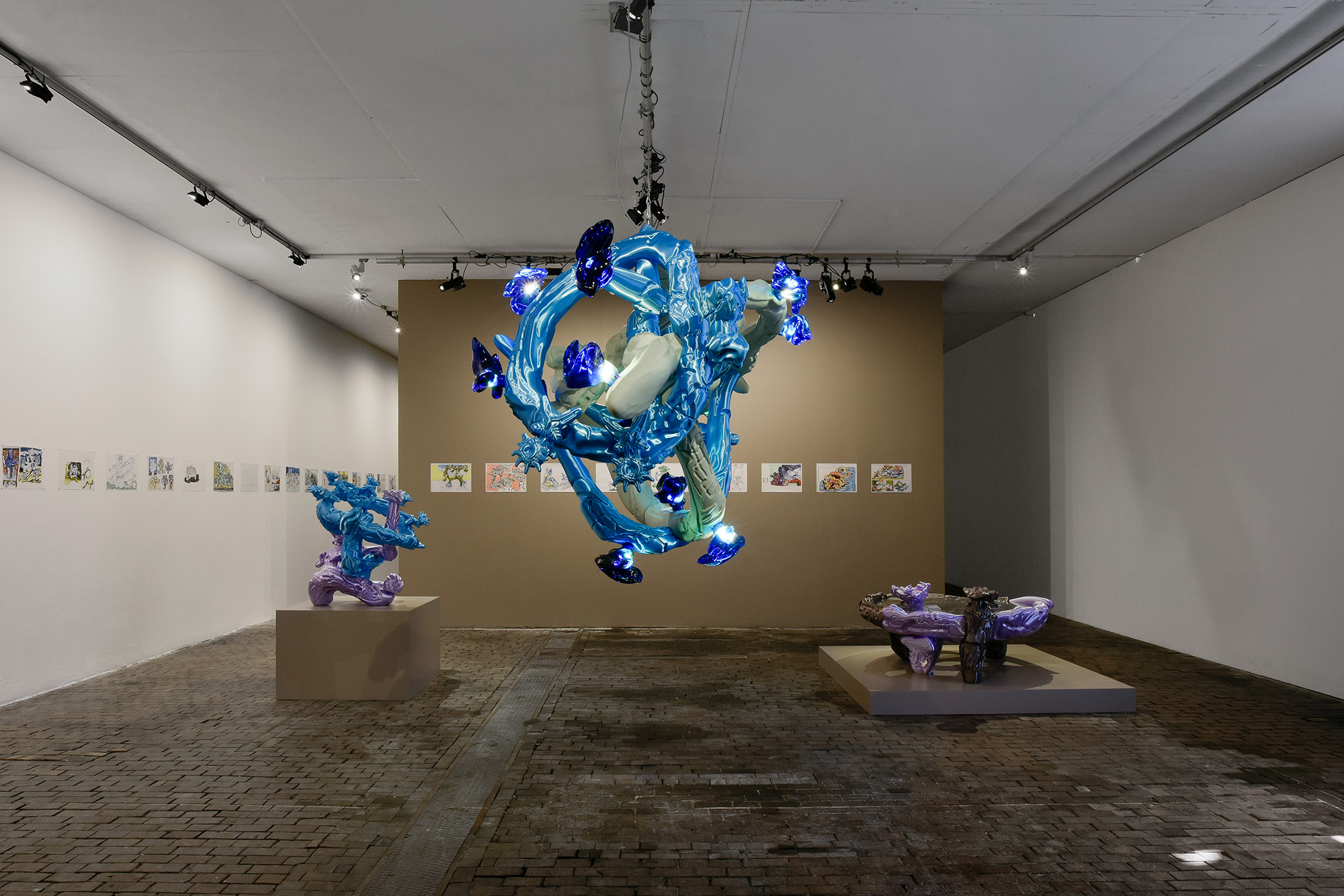
Geneva – a city which not so much straddles the Switzerland/France border than is entwined with it – is perhaps best known now as a centre of finance and diplomacy, a city of invisible hands moving invisible finance and anonymous technocrats handling secret negotiations. It is a city which has transitioned into one built around the management of abstraction and service of ideas out of what was a centre of watchmaker, jeweller, and craftsman Protestant refugees escaping France following the 1598 Edict of Nantes. It is then perhaps an entirely suitable context to think about the idea of metamorphosis and the betweenness of states, the migration of form or idea.
Both Large and Blandet are emerging French born creatives both now residing in Rotterdam, and this exhibition relocates their design-focused artworks into this former Genevan industrial concrete hulk of a bulding. At first glance the works read as furniture design, functional lumps of domestic design, albeit with brightly coloured and baroque flourishes. And so, sitting on plinths and reading as products of manufacture, they read suitably at home within such an industrial setting, within a place and history which was surely also about something as logical, physical, and immediate as product design.
But as visitors encircle the works to understand more, the floor continues to creak and crack. The foundations are unreliable, things may not be what they seem, everything here is in-between.
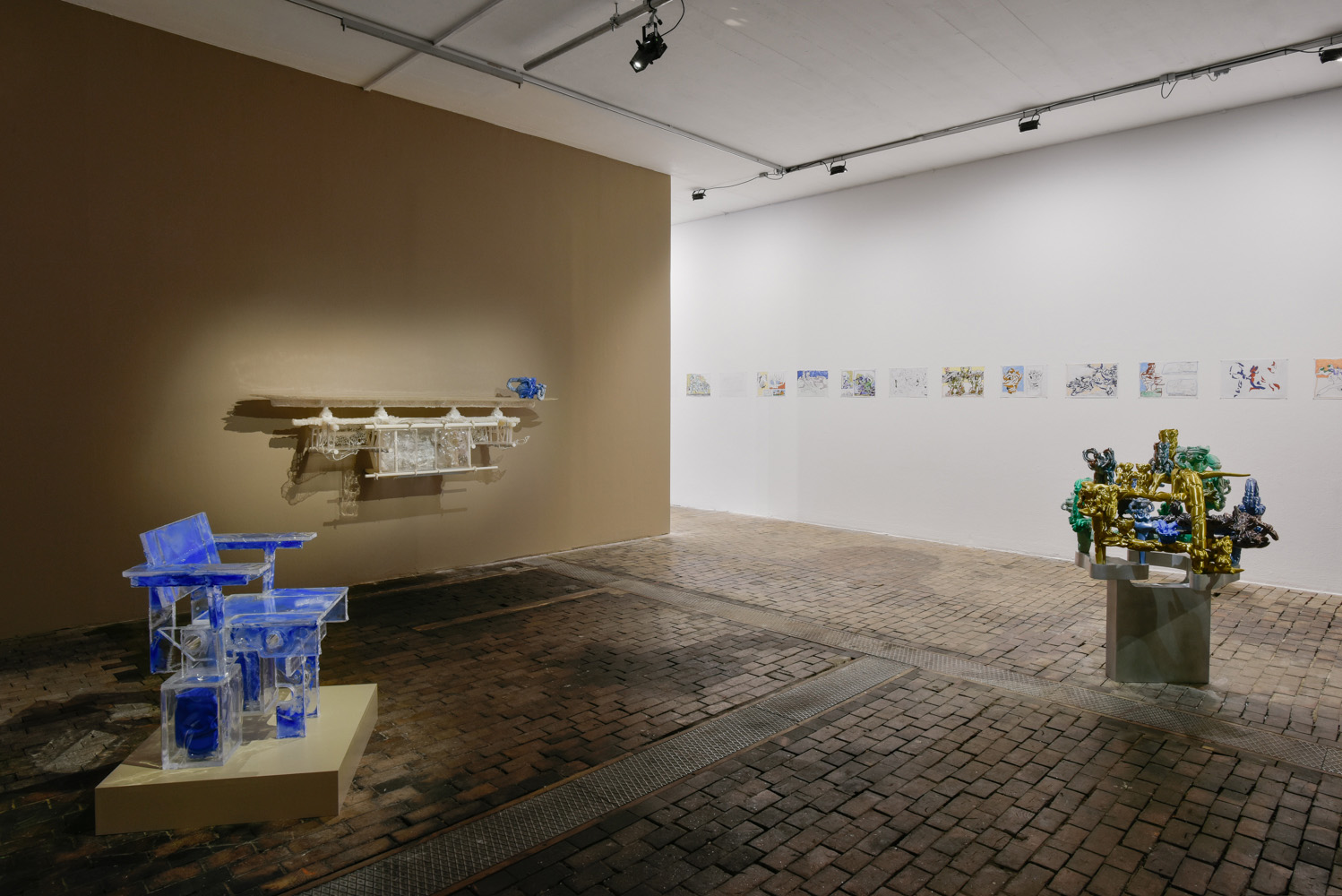
A chair sits, waiting to be used. It could be used, though it’s not inviting, functional but threatening. PPC-DH (Chair) (2019) by Blandet sets the tone, this is no architect-designed experiment in ergonomics, but more a statement of materiality, and some kind of melted, reconstituted, disturbed, deformed material at that. Half furniture design half art object, it is lumpen yet fluid with a geometric rough-cut rigidity fighting a blue marbling within, a site of change and transformation.
Nearby, an equally functional shelf also presents itself with horror. The top surface of Blandet’s PS (Wall Cabinet) (2018) is flat but everything else seems to be melting into time and space. Blandet describes it as “basically made of trash I found around my atelier in Eindhoven,” but the gallery listings offer an ingredients list: PS, PE, HDPE, POM, PCL, PETG, PTFE, PA, PMMA, HMA, PU, and polyester. This all speak to chemical (or alchemical?) ideas of melting, reacting, breaking apart, but also bonding, and it seems that somehow within that unlikely cocktail of letters there was a moment of bonding in which something functional accidentally formed. As if to evidence that function, the curators Barbara Brondi and Marco Rainò have perched one of Large’s works. Metabowl#13 (2020) is a small serpentine lump of 3D printed forms, half-on half-off the precarious surface.


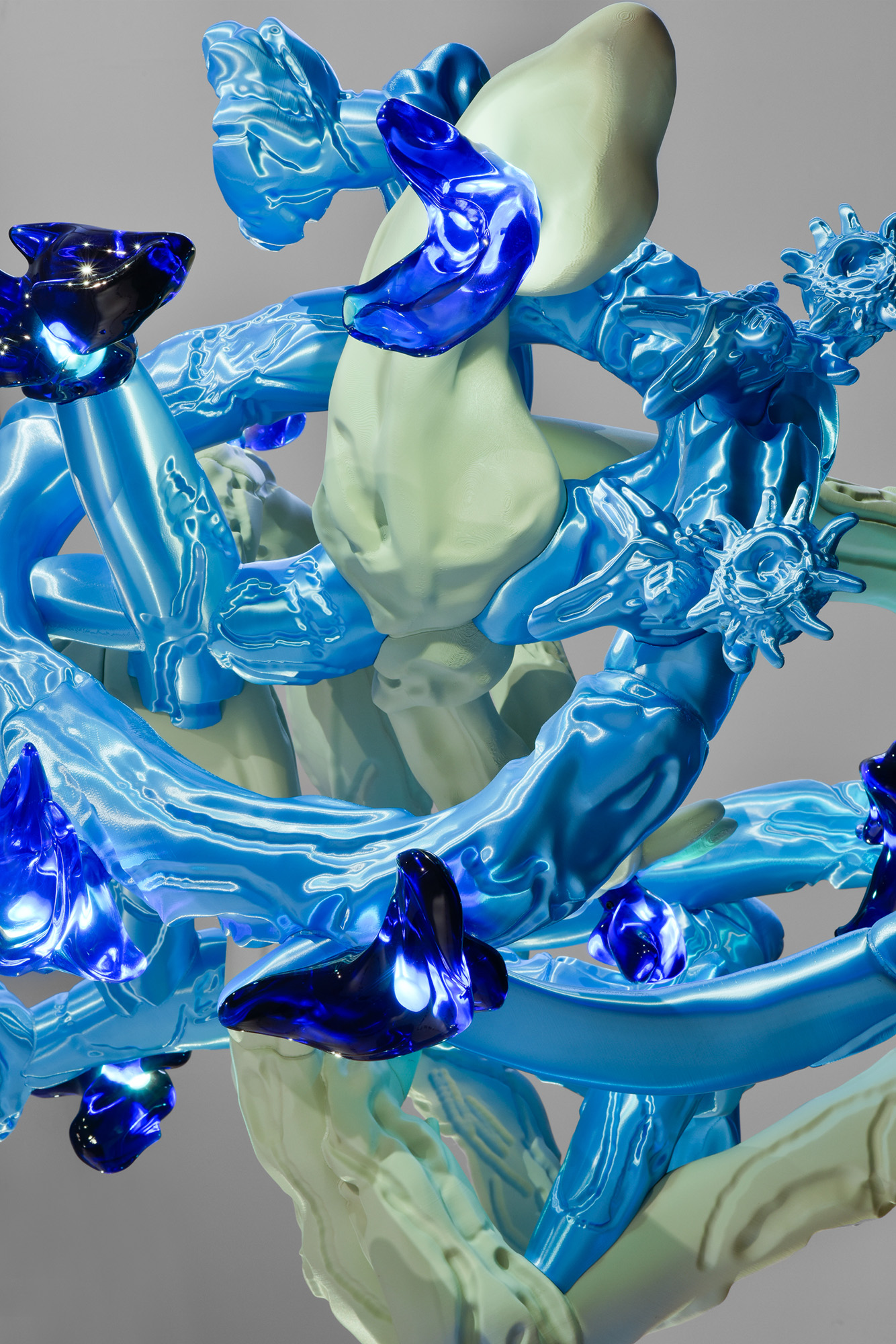
Other works in the room by the Large are greater in scale and baroque form. Scale to Infinity (2021) is typical of Large’s sculptural objects, a seemingly chaotic amalgamation of 3D printed shapes interlocking, unashamedly showing joins and scars. “It is hand drawn and crafted in the blank space of 3D modelling software,” Large explains, pointing out shapes and forms that repeat not just within a work but across pieces as she builds a library of elements that deform and bend into new abstractions. “Is it made by human or machine, created by computer or person?” the artist asks rhetorically, answering herself: “It’s about a new dichotomy.”
We are deeply into the slow metamorphosis between analogue and digital. Some may say it began in the 1960s with cybernetics, others in the 1980s with home computers, perhaps deeper in time with Ada Lovelace. We don’t know, however, when or where it will end, and if we will reach a time when analogue is forgotten to history. We don’t know if the analogue-to-digital metamorphosis will end or forever mutate within the messy in-between. These works by Blandet and Large symbolise that in-between, or as Large describes it “a bridge between two worlds.”
Where Large lives in the digital realm of 3D software, Blandet’s work is fundamentally handmade – “He uses a hammer, so it’s really crafted,” suggests Rainò. As with the shelving earlier, many of the works are from found materials, rescued, and reimagined in a process the artist describes as “a journey about how you can make things by hand out of a material that is completely industrialised.” As a consequence, Blandet’s pieces do have a somewhat scavenged cyberpunk feel: rough-cut edges, melted joins, folded and twisted surfaces.
Perhaps suitably for an exhibition in Geneva, Blandet’s work often carries an aura of Swiss artist H.R. Giger about it. Wires spill out of the petal-laden orifice of a bitcoin mining cooling system, wrapping around a long pole are blue leaf-like growth emitting crystalline light, and in the centre of the room an absurdist tea fountain on wheels, seemingly melting under the weight of its own otherness. This sci-fi is sinister.
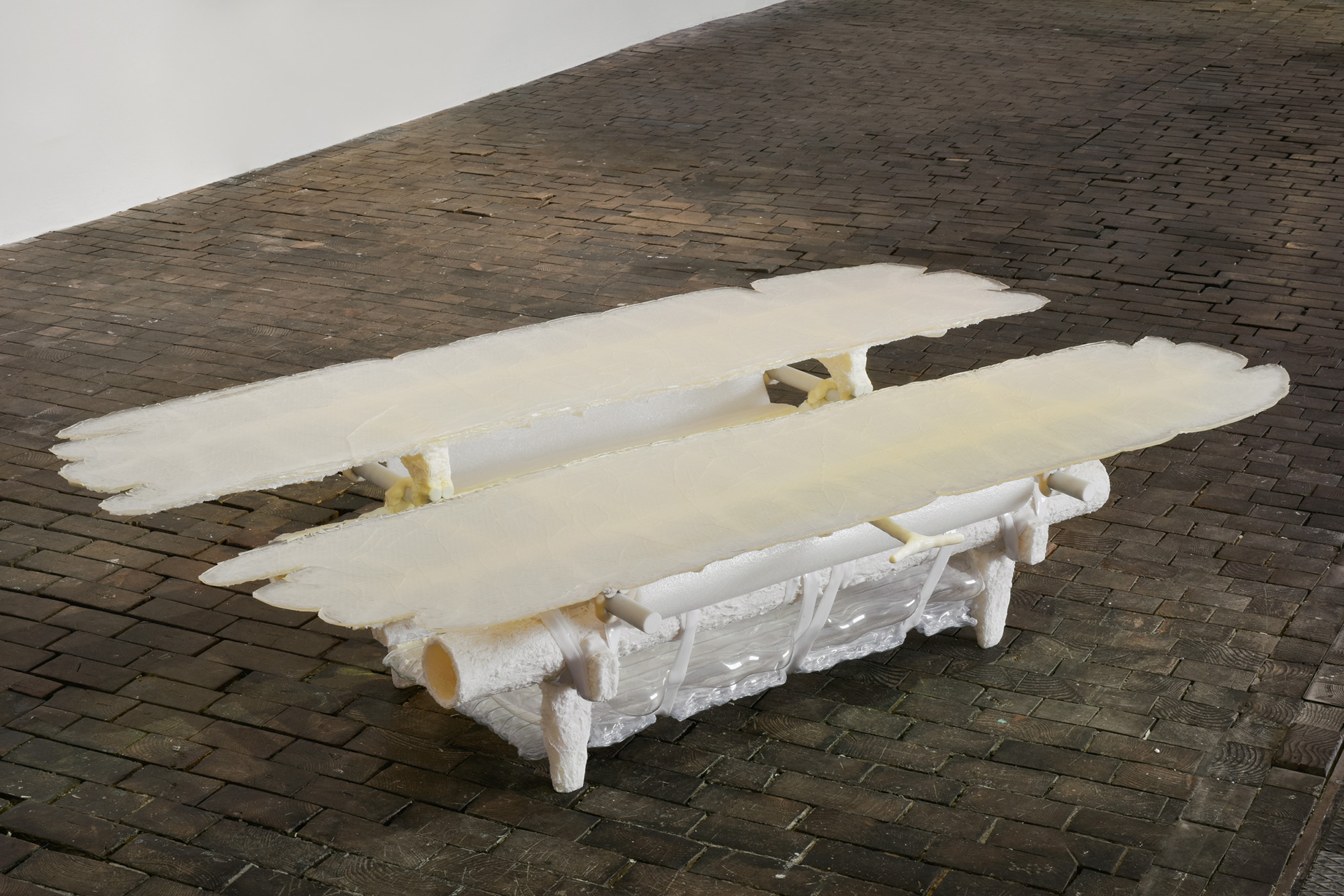


But behind the sinisterness of both artists’ creations, there is potential functionality as lights, tables, chairs, and desks – though the function is often concealed behind an art-object aesthetic, hidden amongst sculptural form. Large’s MetaShelve#1 (2020) conjures a feeling of Apollo and Daphne by Gian Lorenzo Bernini – if Bernini had eschewed marble in favour of garishly purple plastic. But where in the great baroque sculpture Daphne is transforming into a laurel tree as representation of Ovid’s tale, Large’s work has at its core the very functional mundanity of a shelving unit.
The artists have collaborated on two works, both centred on logic. Larges’s pieces sit upon a chessboard table made by Blandet, while nearby a low-slung circular light connects twisted branch-like metal lumps by Blandet, dovetailing neatly with equally-twisted glowing orbs from Large. It seems to glow by itself, separated from logic, through a clever system by which the supporting wires carry low-voltage charge which then wraps around and through the very sculptural components themselves.
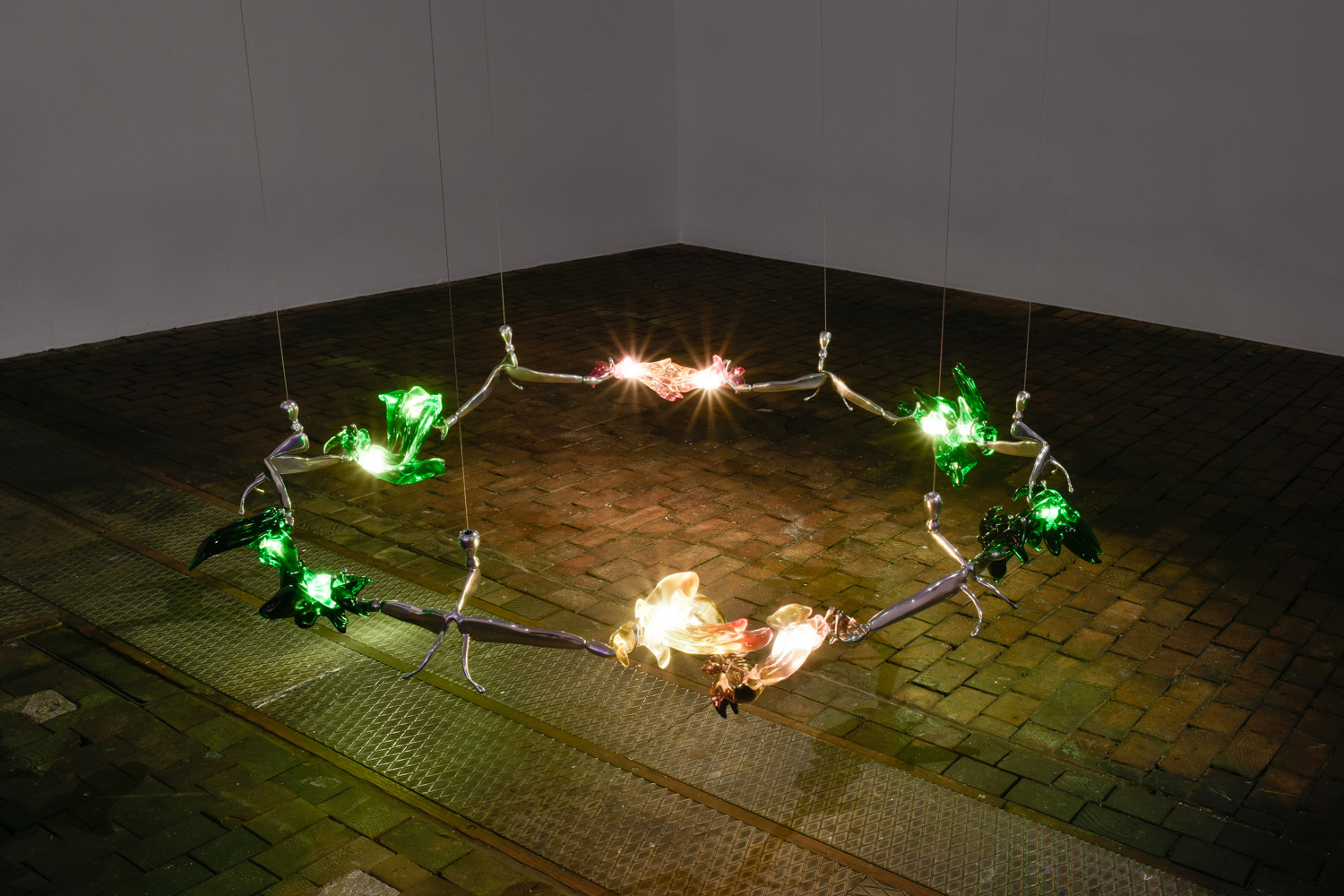


Three other lights are where Large’s work starts to sing and show a play of material a step beyond her otherworldly dayglow rococo works. Small tabletop lights read as alien illuminated twists wrapping around weathered and time-hewn timber and stone. On closer inspection something doesn’t feel right. What registers as marble and wood is in fact an applied digital mapping, applied to 3D forms through a suminagashi – or floating ink – technique, adding a further beguiling twist to the form.
Two chairs sit facing away from one another. One is formed of bonded plastic sections Frankenstein-like clenched together. The other entirely metal, like a castoff from clinician chair factory, looking too dangerous and terrifying for any medical use. A wall-mounted cabinet carries projects the same threatening aura, another Giger-like skeletal form which despite its intimidating front is entirely functional.


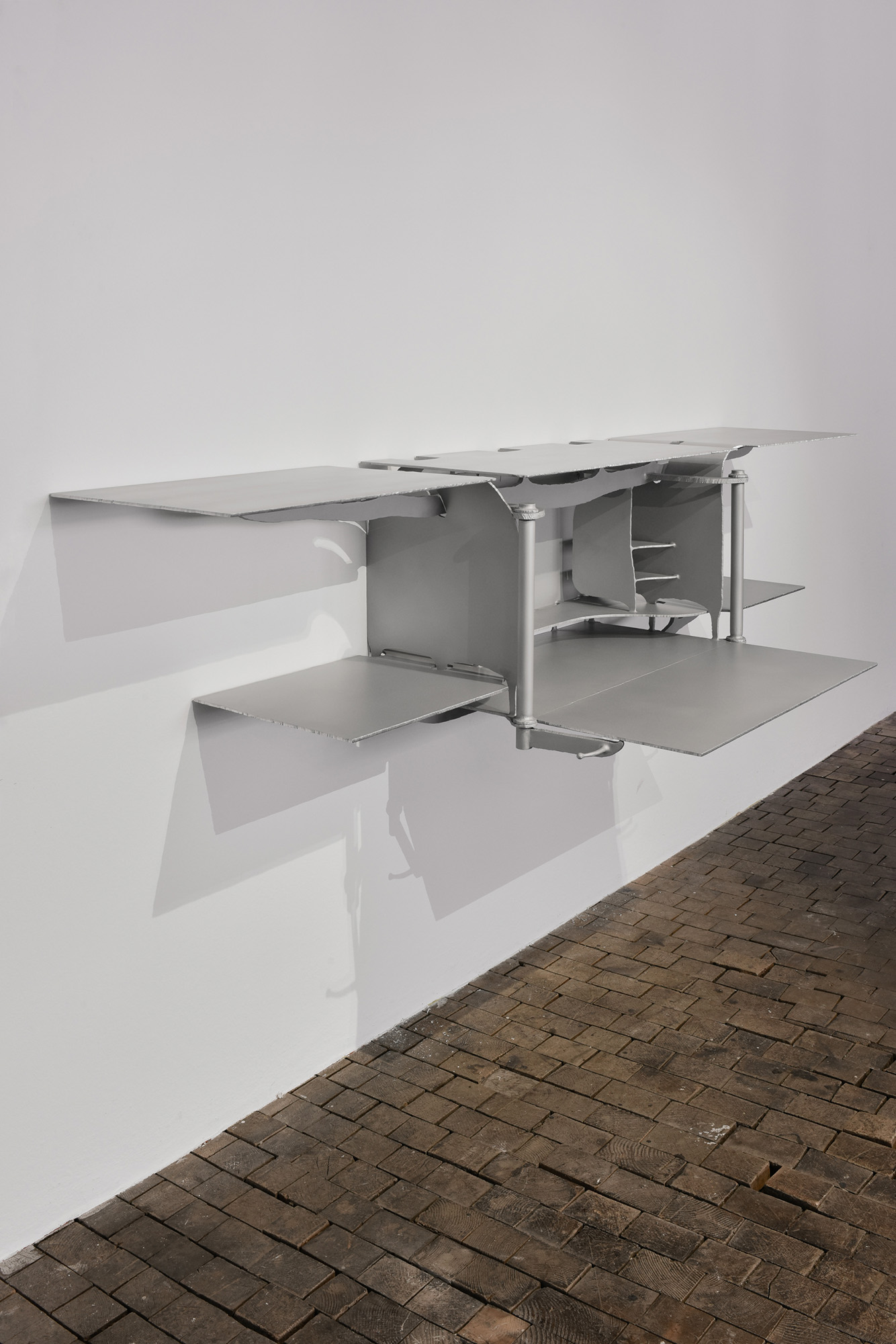
Of his process, Blandet says “when I start an object I never know what it will be at the end,” and while there usually is a semblance of order and function hewn from his found materials, the final piece on show in the exhibition is less secure in its meaning. In a room, all by itself, stands Pole (Shelve) (2022), a series of flat, intertwining levels arranged around a floor to ceiling pole which spins on its axis. After all the pieces witnessed which conceal their potential purpose beneath sculptural imagination, here it is hidden more deeply. Alone in the room it stands withholding what it may one day become: a standing table, consumerist display, medical equipment, torture apparatus.
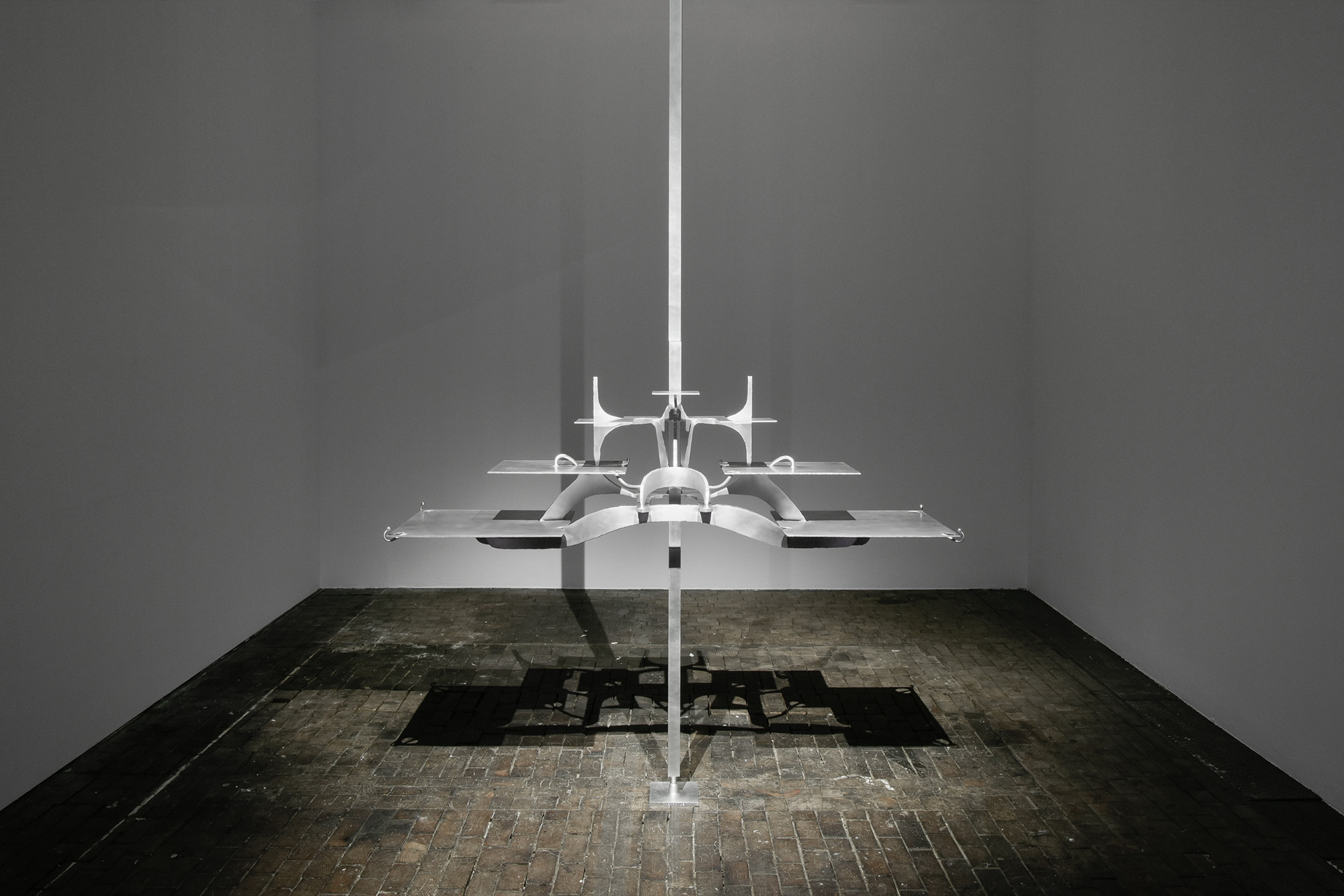
At the end of 2024, the Centre d’art Contemporain Genève will temporarily shut down, moving its work offsite and online as the former industrial building around it is updated a further time. The rattling wooden blocks on the floor from another age may not survive. Misshapen, detached, and saturated with pollutants from the past, they might well be ripped out and replaced.
At a time when we are searching for ways to confront new futures words like retrofit, adapt, update, hack, modify,tweak, update, and renovate are commonplace. The building and the materials it is formed of is on a continual metamorphosis, just as these works within it speak to that endless process from what was before to what is next. The wooden blocks will no doubt find some new function, probably not their final state, just another staging post in the continual morphosis everything is in.
Seed → Tree → Floor → Unknown futures...
Audrey Large (b. 1994, Bordeaux, France) currently lives and works in Rotterdam. She graduated from MA Social Design at Design Academy Eindhoven in 2017. Her works set off a dizzying calling into question of the authenticity of the vision and perception of what is considered tangible and therefore real, positioning herself in contemporary design territory with strong points of contact with visual art and material manipulation practices derived from digital cinema, image theory and three-dimensional printing techniques.
Designer-in-Residence at the Jan Van Eyck Academy in Maastricht in 2019-2020, she won the Dutch Designer Award in the Young Designer category in 2021.
Her work has been exhibited as part of group shows at major international museums, such as the Stedelijk Museum in Amsterdam (which also acquired one of her works in its permanent collection), the Design Museum in London, the Vitra Design Museum in Weil am Rhein, and the Nxt Museum in Amsterdam.
Her works MetaCup, Metabowl #1 and Metabowl #2 have become part of the collection of Centre national des arts plastiques (Cnap) in France. She works with Milan’s Nilufar Gallery, who dedicated her a solo exhibition in 2021. She is among the co-founders of Morph collective, a multifaceted working group that since 2018 expresses itself by creating built environments, immersive installations and exhibition concepts.
www.audreylarge.com
Théophile Blandet (b. 1993, Strasbourg, France) currently lives and works in Rotterdam. He graduated from MA Contextual Design at Design Academy Eindhoven in 2017. His works are summary devices that combine the antithetical logics of lucid engineering precision with those of the amateur, validating themselves as discourse-objects that have what it takes to stimulate spurious narratives, caught between fiction and non-fiction.
Always marked by deep research into materials, its expressiveness is revealed by an original practice that combines high craftsmanship with production techniques derived from the most sophisticated industrial processing.
Winner in 2017 of the Kick That Ass Award – Marteen Baas, he has exhibited in group shows at the Design Museum Den Bosch in s-Hertogenbosch as well as in major fairs such as Design Miami and FIAC in Paris; his work has also been hosted in exhibitions at the K11 Art Foundation in Guangzhou and FRAC Ile-de-France, while he has been featured in solo shows at Galerie Fons Welters in Amsterdam and Functional Art Gallery in Berlin.
His WFC chair became part of the collection of Le Centre national des arts plastiques (Cnap) in France. He is among the co-founders of the Morph collective, a multifaceted working group that since 2018 expresses itself by creating built environments, immersive installations and exhibition concepts.
www.theophileblandet.com
Barbara Brondi and Marco Rainò (both born in Turin, Italy in 1970) are architects, designers and independent curators who live and work in Turin. They are interested in experimentation through their planning practice, theoretical research and critical thinking about architecture, contemporary design and graphics.
In 2002 they established BRH+, a firm devoted to design characterised by a comprehensive approach, derived from the concept of architectural practice open to the convergence of disciplines.
Promoters of numerous exhibitions and authors of several publishing projects, they are interested in a critical investigation that aims to intercept the new forms of expressive sensitivity related to the practice of contemporary design thinking; in this experimental direction, they stand out as initiators and curators of the IN Residence program, an innovative talent scouting and educational-training project that consists of many initiatives.
Their projects are featured in numerous international magazines. Marco Rainò is also Artistic Director and Strategic Director of the Interior Design Department of the IAAD Academy (Istituto d’Arte Applicata e Design) in Turin and Bologna.
www.brh.it/eng
Always marked by deep research into materials, its expressiveness is revealed by an original practice that combines high craftsmanship with production techniques derived from the most sophisticated industrial processing.
Winner in 2017 of the Kick That Ass Award – Marteen Baas, he has exhibited in group shows at the Design Museum Den Bosch in s-Hertogenbosch as well as in major fairs such as Design Miami and FIAC in Paris; his work has also been hosted in exhibitions at the K11 Art Foundation in Guangzhou and FRAC Ile-de-France, while he has been featured in solo shows at Galerie Fons Welters in Amsterdam and Functional Art Gallery in Berlin.
His WFC chair became part of the collection of Le Centre national des arts plastiques (Cnap) in France. He is among the co-founders of the Morph collective, a multifaceted working group that since 2018 expresses itself by creating built environments, immersive installations and exhibition concepts.
www.theophileblandet.com
Barbara Brondi and Marco Rainò (both born in Turin, Italy in 1970) are architects, designers and independent curators who live and work in Turin. They are interested in experimentation through their planning practice, theoretical research and critical thinking about architecture, contemporary design and graphics.
In 2002 they established BRH+, a firm devoted to design characterised by a comprehensive approach, derived from the concept of architectural practice open to the convergence of disciplines.
Promoters of numerous exhibitions and authors of several publishing projects, they are interested in a critical investigation that aims to intercept the new forms of expressive sensitivity related to the practice of contemporary design thinking; in this experimental direction, they stand out as initiators and curators of the IN Residence program, an innovative talent scouting and educational-training project that consists of many initiatives.
Their projects are featured in numerous international magazines. Marco Rainò is also Artistic Director and Strategic Director of the Interior Design Department of the IAAD Academy (Istituto d’Arte Applicata e Design) in Turin and Bologna.
www.brh.it/eng
Centre d’Art Contemporain Genève was founded in 1974 as a place for exhibition, discussion and reflection on contemporary art. A pioneer and reference institution on the Swiss and international art scene, the Centre d’Art Contemporain Genève raises the major issues of our time.
A space for research and experimentation, the Centre presents to all audiences ambitious projects, often produced for the occasion, involving all fields of contemporary practice: installation, music, painting, performance, photography, photography, sculpture, dance, drawing or video art, with a unique program of events and projections within its Dynamo Cinema and the Biennale of Moving Images as its high point.
The dynamic and lively program proposed by the Centre, in the form of temporary exhibitions and inclusive and educational cultural activities in innovative formats, promotes creation and encourages active civic participation in contemporary culture.
During 45 years of activity, the Centre has presented more than 300 exhibitions of national and international artists, participated in the discovery of emerging talents or the rediscovery of established figures, hosted local artists in residence and organized numerous educational and socio-artistic activities.
www.centre.ch/en
Centre d’Art Contemporain Genève was founded in 1974 as a place for exhibition, discussion and reflection on contemporary art. A pioneer and reference institution on the Swiss and international art scene, the Centre d’Art Contemporain Genève raises the major issues of our time.
A space for research and experimentation, the Centre presents to all audiences ambitious projects, often produced for the occasion, involving all fields of contemporary practice: installation, music, painting, performance, photography, photography, sculpture, dance, drawing or video art, with a unique program of events and projections within its Dynamo Cinema and the Biennale of Moving Images as its high point.
The dynamic and lively program proposed by the Centre, in the form of temporary exhibitions and inclusive and educational cultural activities in innovative formats, promotes creation and encourages active civic participation in contemporary culture.
During 45 years of activity, the Centre has presented more than 300 exhibitions of national and international artists, participated in the discovery of emerging talents or the rediscovery of established figures, hosted local artists in residence and organized numerous educational and socio-artistic activities.
www.centre.ch/en
visit
Audrey Large & Théophile Blandet
Design in Metamorphosis is exhibited at
Centre d’Art Contemporain Genève until 13 august.
Further details available at:
www.centre.ch/en/exhibitions/audrey-large-and-theophile-blandet
images
All photographs:
Exhibition
view of Design in Metamorphosis with Audrey Large / Théophile Blandet at
Centre d’Art Contemporain Genève
(June 23‒August 13, 2023). ©
Centre d’Art Contemporain Genève. Photo: Mathilda Olmi
publication date
17 July 2023
tags
3D printing, Baroque, BRH+, Gian Lorenzo Bernini, Théophile Blandet, Barbara Brondi, Centre d’art Contemporain Genève, Chair, Craft, Design, Digital, Floor, France, Furniture, Geneva, HR Giger,
Industrial, Will Jennings, Audrey Large, lighting, Melting, Morphosis, Ovid, Plastic, Product design, Marco Rainò, Rococo, Sculpture, Suminagashi, Switzerland, Wood
Further details available at:
www.centre.ch/en/exhibitions/audrey-large-and-theophile-blandet


